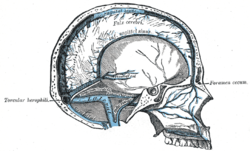| Cerebral veins | |
|---|---|
 Sagittal section of the skull, showing the sinuses of the dura. (Cerebral veins labeled at center left.) | |
| Details | |
| Artery | Cerebral arteries |
| Identifiers | |
| Latin | venae encephali, venae cerebri |
| MeSH | D002550 |
| TA98 | A12.3.06.001 |
| TA2 | 4901 |
| FMA | 70861 |
| Anatomical terminology | |

In human anatomy, the cerebral veins are veins in the cerebral circulation which drain blood from the cerebrum of the human brain. They are divisible into external (superficial cerebral veins) and internal (internal cerebral veins) groups according to the outer or inner parts of the hemispheres they drain into.